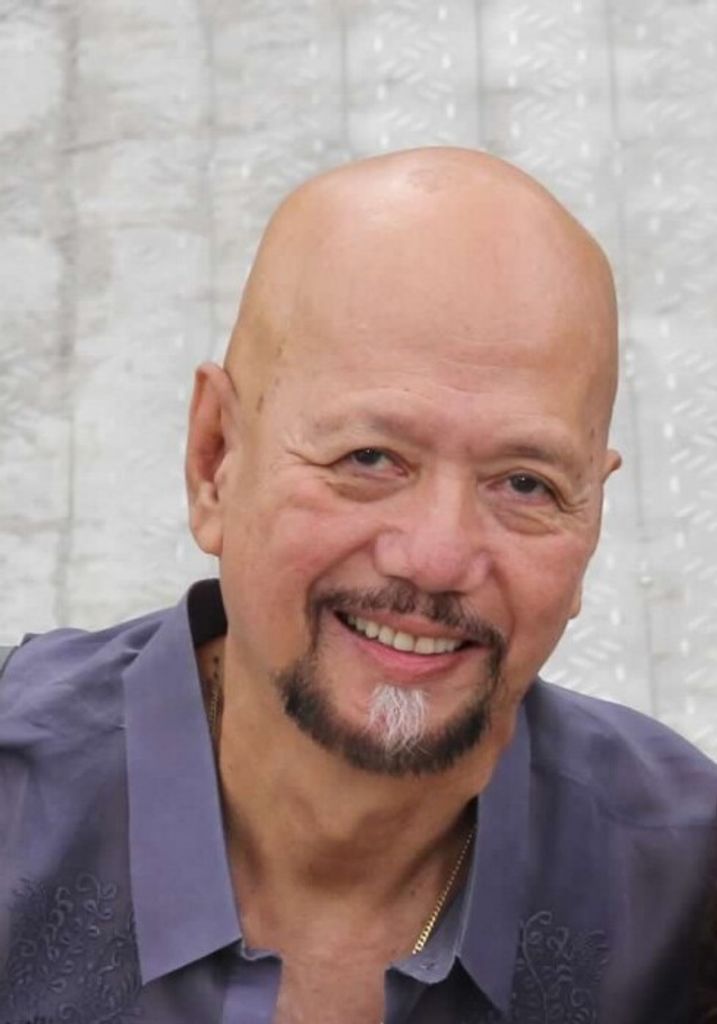19,
1944

10,
2020
OBITUARY FOR ERLINDO DE GUIA, JR.
PART ONE: LIFE IN THE PHILIPPINES
By Edelwina “Winnie” Parungao
ERLINDO DE GUIA, JR. was born on June 19, 1944 during World War II in Minalabac, Camarines Sur to Dr. Erlindo de Guia, Sr. and Elsa Granados Nomorosa-de Guia. Minalabac is a small town in Camarines Sur, Bicol Region in the Philippines. Our father, ERLINDO DE GUIA, Sr. was a physician from Manila, who fell in love with Bicolandia and brought his young bride, our mother, to Naga City (capital of Camarines Sur) where he was the head of the Camarines Sur Provincial Hospital. Our mother was a teacher who finished at the Philippine Normal School. When World War II broke out, our father joined the guerilla movement (to fight off the Japanese) where his medical services among the troops would best be served. Per stories of our parents, our brother, whom we fondly call KUYA (“Big Brother”) ErLINDO or the eldest brother in a brood of seven children) was named after our father but he bore the long name of ERLINDO JOSE RIZALITO DE GUIA (named after Jose Rizal, the Philippines’ national hero with the same birthdate). As a baby, he had a warm bath from water in a big basin dried under the sun. One time, he almost gave away the hiding place of our parents when the Japanese were looking for them; were it not for our Mama’s quick thinking to breastfeed him, they could have been killed. After the war, they returned to Naga City where our Papa headed the Naga City Puericulture Center for primary medical care, to be closer to the family. They started from scratch, first renting a very simple house along Barlin St., near the Naga Cathedral and the catholic schools we attended. We lived happy moments and days growing up there. Kuya Lindo was very intelligent. He started elementary school at 4 years old in the Naga Parochial School (beside the Naga Cathedral and Seminary); he finished elementary with honors at 10 years old and went to Ateneo de Naga School (run by Jesuits, and now a university) to finish high school 14 years old and completed college studies at 19 yrs old. We all grew up as a happy family in the house we were renting close to our schools and although both our parents were busy, they found time to be with us children. Highlights were going out to watch movies together whenever possible because we were free at all the movie houses (freebie for the doctor, an OB who practically delivered all the babies of prominent families in the city), parties to celebrate a birthday of each child, fiestas are open house to whoever would like to enter, going to Mass together on Sundays, and grand family celebrations/reunions every New Year where we had a family photo taken every year. All 7 of us children were literally “made and delivered” by Papa. He would not entrust us to anybody.
The portrait of one big happy family started to break apart when our Mama had a heart attack when we were very young, Kuya Lindo was still a teenager but to me and the rest, it was a blur. All that I remember was Kuya Lindo keeping a vigil eye over Mama’s side, silently watching her and grieving over her until our Papa brought her to the Philippine General Hospital where she fully recovered. All the time Mama was sick, Kuya was silently grieving as if he lost the world and he was never the same. He watched events unfolding in our family, silently, quietly and would intervene if things got out of control. Then later, Papa built the “big house”, his dream house located at Igualdad St., Naga City. It was one of the most beautiful houses in Naga City then, with narra wood, 5 bedrooms and adjacent lot where he planned to build a hospital. However, to build the house and buy the lot, Papa and Mama were loaded with debts/loans and it weighed heavily on both of them to the point that they moved the family to Manila since Papa’s medical practice floundered. It was in July 4, 1962 that Papa died in his sleep in Sampaloc, Manila, leaving behind a young widow, and 7 children from ages 4 to 16. One asks the question: how was Mama by herself, able to face that big responsibility of solely raising the 7 children, all still of school age? But she managed to keep us together, as a teacher employed in catholic schools, instead of “giving us away” to various relatives. Sadly, we “disintegrated and got separated” when Papa died. Kuya was the first to make a sacrifice. Since our parents instilled in us the value of education, something they said would be the best inheritance they could give us and nobody can steal away from us, Kuya Lindo made the sacrifice of staying behind in Naga City, supporting himself by doing janitorial jobs in Ateneo to finish his degree. From a lofty position of belonging to a prominent family, he became a “laborer”. There was no shame in it for him. It was a labor of love, a discipline he practiced when he raised his own family in Baguio City. As for the remaining 6 children, those were turbulent years when we were consigned temporarily for short periods to different uncles or aunties until Mama wemt passed her grieving and mourning for Papa’s loss. We were bereft of a father, bereft of fortune, bereft of a house and even bereft of relatives who did not support us. We left Naga City as a family in 1963 and never looked back. The happy days in Naga were gone when we lost Papa.
Feeling the loss of Papa and going over it as she had to move on and take care of her children, Mama, being a teacher, applied for a teaching position in the hinterlands and mountains of Lubuagan, Kalinga, Mountain Province, which is farthest away from Naga City. It was a missionary school of Missionary nuns of the St. Teresita College. The school was an outpost for Igorot children, the indigenous inhabitants of the Mountain Province and it was a dangerous place to live in at that time because of tribal wars amongst the natives who were headhunters. Wars were settled through vengeance; wrongdoers from the other tribe were hunted and their heads cut off. That practice has now stopped in modern times. From Naga City, Kuya Lindo, having finished a college degree, did not join Mama and our siblings in Lubuagan but instead applied for a teaching position in Abacan, a small town also in the Mountain Province. It was very cold there but he enjoyed his stay there amongst vegetable farms; from his meager salary, he sent support for the family. At every occasion, he would join the family in Lubuagan for vacation. We have black and white photos to remember our Lubuagan days. Kuya Lindo, as usual was the big brother hovering over us; he was our surrogate father. The younger ones (No. 3 to 7) studied in Lubuagan amongst the natives there, but since there was no school for quality high school or college education in Lubuagan, Mama brought us all to Baguio City to be together. Kuya Lindo quit his job and we were reunited as a whole family again, and life was happy once more. For us grown-ups who finished school, we found separate jobs to help support our younger siblings. Kuya Lindo worked at Catholic School Press and there met a pretty lady, Ms. June Corpuz. It was in Baguio City, where we when we found our bearings once more as a family. We were all still single. Supporting each other and we were back to our feet again. We were united as a family, started meeting new friends and building a new life, and the courting stage with our future spouses also begun. Kuya Lindo was happy in Catholic School Press, a missionary school where they had a small store and Kuya Lindo worked as a manager in the customer relations department and it was there that he met the love of his life, a petite pretty lady who will later be his wife. He was an incurable romantic and I know he composed letters and poems for the lovely lady. His eyes sparkled, he was laughing again, and hurrah for him and it led to a happy wedding later on.
But once more, tragedy struck for the second time. Mama had a bad aneurysm that caused a massive stroke and nothing could be done. After being hospitalized for more than a year in a charity ward in different hospitals, as we her children, simply could not support her medical bills, we brought Mama home to whatever dwelling we could afford. She became a quadriplegic, lost her speech and had a mentality of an infant. We took turns taking care of her; whoever was around would be the caregiver, feeding her and cleaning her after. We lived in different places, the last was with the help of Kuya Lindo and June where we stayed in a simple shack made of tin which was on a cliff, not passable to any kind of vehicle and could be reached only by walking three (3) kilometers downhill from the main road. It was Kuya Lindo and June who helped us find that place as it was the cheapest we could rent and it was also the nearest to their own place. After Mama passed away on January 2, 1974, there was no reason for us siblings to be together anymore. Mama lived for a purpose: to unite us as a family and her being a sick all the time we were still completing our college education, she was the gel who kept her together. She passed away just as Kuya Lindo already started to have his own family and the others, have already finished their studies except the 2 youngest ones, whom Kuya Lindo partly helped with their education expenses.
When Kuya Lindo started his own family and having kids of his own, he drove himself to the limit. It was alright when he and June were still working at John Hay Base in Baguio City, an American Base near their residence. Those were the happiest days of his life – he would play and cavort with his kids and June every time they were together. But when the John Hay Air Base was closed, he was constrained to accept a job at Poro Point in San Fernando, La Union. He abused his body: every morning he would wake up early to run to the bus station; this was about 4 kilometers from their residence to the bus station and he would board a bus to Poro Point for almost 2 hours of commute and come back home after office hours and arrive at their place dog-tired. All these he endured stoically. Then a lucky break:after all the American Bases including the Poro Point was pulled out of the Philippines, all former workers of the American Bases were given priority to be granted US Visa. Not losing time and the God-given opportunity, Kuya Lindo brought the family to the USA.
Even while in the USA, Kuya Lindo’s nostalgia for the Philippines was always there. He remembered all the good times he spent there, including the natural beauty of his homeland. It is one of his dying wish to go back to Baguio City. His wish will come true. Part of his remains will be inured in the family mausoleum to be laid to rest alongside Papa. Mama and his younger brother, Eunilo. His siblings await their time too when they could be together again and they wish to say, thank you for being there for us, our surrogate father when Papa was gone. Till we meet again, rest in peace, till we meet again.
PART TWO
LIVING THE AMERICAN DREAM
By Junelyn King
I was only 4 years old on July 16, 1990 when the catastrophic earthquake struck the island of Luzon, PI. An estimated magniture of 7.7 that produced a 78 mile -long ground rupture that crumbled many buildings, created landslides, and devastation. Papa was at work in Wallace Air Station, over 10 miles away from our home. Roads were destroyed and our family was scattered throughout the town, in the early hours after the quake our family was reunited and dreaded in fear of who survived and who didn’t. Papa was the last one to arrive home in the darkness, well after midnight. After reuniting with us with the comfort of knowing his family was safe he then made it his personal duty to help other families. He was awarded civilian honors for his efforts in assisting the Fairfax County Fire & Rescue Department as a volunteer worker for the U.S. International Rescue Team, during their rescue operations at the Nevada Hotel. He was recognized as going above and beyond the call of duty as an USAF employee in entering the ruins, despite aftershocks, to help the rescue and retrieval of an official of the USAID mission and other quake victims.
As a kindergartener, I remember Papa was him picking me up at in St. Louis University Laboratory Elementary School, in Baguio City, Philippines. I remember grabbing his calloused hands as he led me through the crowd to the secured metal chained gate to exit the school. We would ride the jeepney together to the local market. Jeepneys are cultural icons of the Philippines, remodeled military vehicles left behind from World War 2 that now serve as public transportation. I would sit on his lap and he would hold me tight to protect me from the bumps and turbulent roads. After school, he would take me to get street corn and ice cream, followed by a nap at our home. I remember placing my head on his chest and falling asleep to the sound of his heart beat. He was the perfect balance of tender, loving, and discipline.
Our family’s home was located in Hillside, it was a beautiful two story home perfect for our family. Papa appreciated art, Philippine culture, and true craftsmanship. His favorite piece was our dining room table, hand-carved indigenous Narra wood which served as a focal point and symbolic gathering piece for the family. Many family gatherings occurred around that table with a large spread of his favorite Filipino food, cooked by Mama and other family members during many celebrations.
It was my seventh birthday when we had a large party to celebrate our move to the United States. It seemed like the whole town celebrated with us. My brother Ernesto and Papa were the first to leave the Philippines. Papa was gone for three months in preparation for the rest of my siblings and Mama’s immigration.
There was so much excitement about this new country and I was just excited to see my papa again. My family arrived and I remember running into the crowd searching for my Papa, finally able to jump in his arms. We lived with my aunt, his sister, Nora’s basement until we transitioned into a 2 bedroom apartment. He worked two jobs tirelessly processing paperwork and checks in Crestar in Glen Burnie, MD during the day time, coming home for one hour to rest and then clocking back in as a custodian in University of Maryland, College Park until midnight. He worked 80 hours a week, to make ends meet and to save enough money for his next goal. After 6 years in a rented space of that first level apartment, him and Mama found a beautiful four bedroom single family home located in a peaceful town of Berwyn Heights. He loved sitting outside listening to the birds, watching four seasons, and walking to Lake Artemisia.
He was able to cut back to his day job at Crestar and enjoyed dinners with his family again until he retired at 70 years old. His family threw him a retirement party where he spoke about living his American Dream. Not only did he retire, he also paid off the mortgage of the home he loved and accomplished his goal of “owning a piece of America.” He had an uncanny ability to capture a crowd’s attention with a witty story or impromptu speech. That evening he spoke about how “love is forever.” He beamed with happiness and pride during that evening. He picked up his granddaughter Jasella, 7 years old at the time in his arms, looked her in the eye and asked her, “Look in my eyes. What do you see?” She responded saying “Lolo you are happy!”
At retirement age he enjoyed simple pleasures of gardening, traveling, and most of all spending quality time with his grandchildren. He travelled with my sister Jennifer, “Charmaine” to various locations, all over California where she lives. He marveled at the beauty of Napa Valley, with a glass of wine saying, “I am so proud of you my dear daughter, I have only read about this place in novels and seen it in movies and now I get to experience it with you.” He also travelled with her to Las Vegas, Canada, Grand Canyon, Niagara Falls, etc.
Even in retirement Papa looked much younger than his age but his knees were saying otherwise. He was not one to complain about pain but he started to have difficulty walking long distances. He decided to get a consult for knee replacements and through the screening process he was diagnosed with a rare chronic blood cancer, myelofibrosis in October of 2019. After this diagnosis he made it a goal to prepare our family for the inevitable. He captured many pictures with his grandchildren and spent the time he could to make them laugh and build everlasting memories. He had plans of going to Hawaii in March 2020 with Charmaine and her family until COVID-19 spoiled their plans. Instead he spent three months in Delaware near Bethany Beach with my family. Being a nurse I was able to help him navigate through the healthcare system and coordinate his care. While in quarantine we enjoyed golf cart rides on the beach, campfires and barbeque at our campground in Tuckahoe Acres located in Dagsboro, DE. He spent many mornings cuddled up with his youngest grandchild, Julianna listening to nursery rhymes and enduring musical choices by Jordyn and Braelyn. Several months passed and he was missing his home in Berwyn Heights, MD.
Upon his return home he continued to garden with my Mama in their large backyard, planting tomatoes, flowers, and other vegetables. He spent more precious moments with his sons Ernesto and Enrico and their family. He was stoic during his battle with myelofibrosis and then he was hospitalized at Holy Cross Hospital. Visitations were limited due to the virus and he had a large family who virtually visited him through zoom, a video telephony communication platform. He remained at the hospital until Mama and Charmaine was with him until his last breath.
He had the gift of kindness and conversation and most everyone who had the pleasure of knowing him will remember his warm smile and gentle spirit. He was the one to lead the family in prayer and always ingrained the importance of God and family. He has left behind a legacy that will live on in the hearts of his family. He is survived by his wife, June de Guia; children Ernesto de Guia and his wife Tracylynn de Guia, Jennifer Victorio and her husband Jason Victorio, Enrico de Guia and his wife Iolanda Barcu, Junelyn King and her husband Brad King; siblings Edelwina Parungao, Egidio de Guia, Ednora Franco, Ermelo de Guia, Emmanuel de Guia; grandchildren Cherie Denielle de Guia, Ronie de Guia, Rosie de Guia, Jasella Victorio, Bryson Victorio, Jordyn King, Braelyn King, and Juliana King;.
Pallbearers will be Ernesto de Guia, Enrico de Guia, Brad King, Jason Victorio, Jose Parungao, and George Franco.
For the past two years Erl admirably fought myelofibrosis. In lieu of flowers the family requests donations to MPNresearchfoundation.org.
*The family of Erl prefers memorial donations rather than floral tributes*
MPN Research Foundation
Web:
http://www.mpnresearchfoundation.org/
To order memorial trees or send flowers to the family in memory of Erlindo "Erl" N. De Guia, please visit our flower store.
Service Schedule
Past Services
Guestbook
Visits: 24
This site is protected by reCAPTCHA and the
Google Privacy Policy and Terms of Service apply.
Service map data © OpenStreetMap contributors




